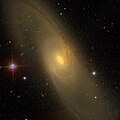
NGC 3596 is an intermediate spiral galaxy in the constellation Leo. It was discovered by William Herschel 1784. It is located below the star Theta Leonis (Chertan). It is a member of the Leo II Groups, a series of galaxies and galaxy clusters strung out from the right edge of the Virgo Supercluster.

NGC 4088 is an intermediate spiral galaxy in the constellation Ursa Major. The galaxy forms a physical pair with NGC 4085, which is located 11′ away.

NGC 6744 is an intermediate spiral galaxy about 30 million light-years away in the constellation Pavo (Peacock). It is considered as a Milky Way mimic in the immediate vicinity, displaying flocculent (fluffy) arms and an elongated core. It also has at least one distorted companion galaxy superficially similar to one of the Magellanic Clouds. It was discovered from Parramatta in Australia by Scottish astronomer James Dunlop on 30 June 1826.

NGC 5921 is a barred spiral galaxy located approximately 65 million light-years from the Solar System in the constellation Serpens Caput. It was discovered by William Herschel on 1 May 1786. In February 2001 a type II supernova was discovered in NGC 5921. It is a member of the Virgo III Groups, a series of galaxies and galaxy clusters strung out to the east of the Virgo Supercluster of galaxies.

NGC 4984 is an intermediate lenticular galaxy exhibiting a double ring structure in the constellation Virgo. It is a member of the NGC 4856 Group of galaxies, which is a member of the Virgo II Groups, a series of galaxies and galaxy clusters strung out from the southern edge of the Virgo Supercluster. In December 2011, supernova 2011iy was discovered in it.

NGC 5300 is a face-on spiral galaxy in the constellation Virgo. It is a member of the NGC 5364 Group of galaxies, itself one of the Virgo III Groups strung out to the east of the Virgo Supercluster of galaxies.
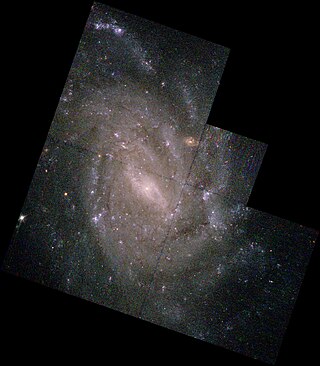
NGC 5334 is a face-on spiral galaxy in the constellation Virgo. It is a member of the Virgo III Groups, a series of galaxies and galaxy clusters strung out to the east of the Virgo Supercluster of galaxies.

NGC 3190 is a spiral galaxy with tightly wound arms and lying in the constellation Leo. It was discovered by William Herschel in 1784. NGC 3190 is member of Hickson 44 galaxy group, estimated at around 80 million light years away, and consisting of four galaxies in a tight group - NGC 3193 is fairly featureless, NGC 3187 is a dim but striking spiral galaxy and NGC 3185 has a barred spiral structure with an outer ring. It is also a member of the NGC 3190 Group of galaxies, which is a member of the Leo II Groups, a series of galaxies and galaxy clusters strung out from the right edge of the Virgo Supercluster.

NGC 5792 is a barred spiral galaxy about 70 million light-years away in the constellation Libra. There is a magnitude 9.6 star on the northwestern edge of the galaxy. It was discovered on April 11, 1787 by the astronomer William Herschel. It is a member of the Virgo III Groups, a series of galaxies and galaxy clusters strung out to the east of the Virgo Supercluster of galaxies.
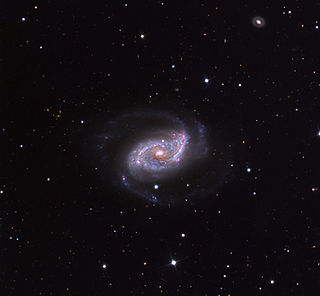
NGC 5248 is a compact intermediate spiral galaxy about 59 million light-years away in the constellation Boötes. It is a member of the NGC 5248 Group of galaxies, itself one of the Virgo III Groups strung out to the east of the Virgo Supercluster of galaxies. Distance measurements to NGC 5248 vary from 41.4 million light-years to 74.0 million light-years, averaging about 58.7 million light-years.
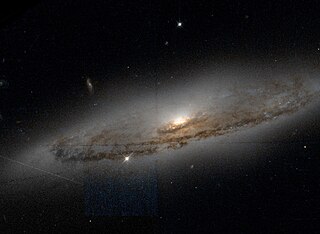
NGC 4845 is a spiral galaxy located in the constellation Virgo around 65 million light years away. The galaxy was originally discovered by William Herschel in 1786. It is a member of the NGC 4753 Group of galaxies, which is a member of the Virgo II Groups, a series of galaxies and galaxy clusters strung out from the southern edge of the Virgo Supercluster.

NGC 7603 is a spiral Seyfert galaxy in the constellation Pisces. It is listed in the Atlas of Peculiar Galaxies. It is interacting with the smaller elliptical galaxy PGC 71041 nearby.

NGC 4519 is a barred spiral galaxy located about 70 million light-years away in the constellation Virgo. NGC 4519 was discovered by astronomer William Herschel on April 15, 1784. It has a companion galaxy known as PGC 41706 and is a member of the Virgo Cluster.

NGC 497 is a barred spiral galaxy approximately 336 million light-years away from Earth in the constellation of Cetus. It was discovered by French astronomer Édouard Stephan on November 6, 1882.

NGC 5774 is an intermediate spiral galaxy approximately 71 million light-years away from Earth in the constellation of Virgo. It was discovered by Irish engineer Bindon Stoney on April 26, 1851.

NGC 5468 is an intermediate spiral galaxy located in the constellation Virgo. It is located at a distance of about 140 million light-years from Earth, which, given its apparent dimensions, means that NGC 5468 is about 110,000 light-years across. It was discovered by William Herschel on March 5, 1785.

NGC 3666 is an unbarred spiral galaxy in the constellation Leo. It was discovered by William Herschel on March 15, 1784. It is a member of the Leo II Groups, a series of galaxies and galaxy clusters strung out from the right edge of the Virgo Supercluster.
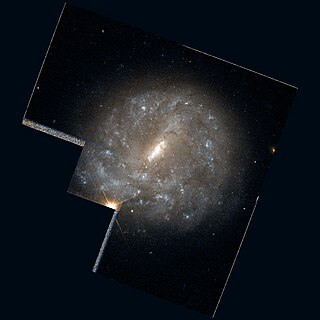
NGC 4900 is a barred spiral galaxy in the constellation Virgo. It was discovered by William Herschel on April 30, 1786. It is a member of the NGC 4753 Group of galaxies, which is a member of the Virgo II Groups, a series of galaxies and galaxy clusters strung out from the southern edge of the Virgo Supercluster.

NGC 4781 is a barred spiral galaxy in the constellation Virgo. It was discovered by William Herschel on Mar 25, 1786. It is a member of the NGC 4699 Group of galaxies, which is a member of the Virgo II Groups, a series of galaxies and galaxy clusters strung out from the southern edge of the Virgo Supercluster.

NGC 3664 is a magellanic barred spiral galaxy in the constellation of Leo. It is located about 80 million light years away from Earth, which means, given its apparent dimensions, that NGC 3664 is approximately 50,000 light years across. It was discovered by Wilhelm Tempel on March 14, 1879. It is a member of the NGC 3640 Group of galaxies, which is a member of the Leo II Groups, a series of galaxies and galaxy clusters strung out from the right edge of the Virgo Supercluster.

